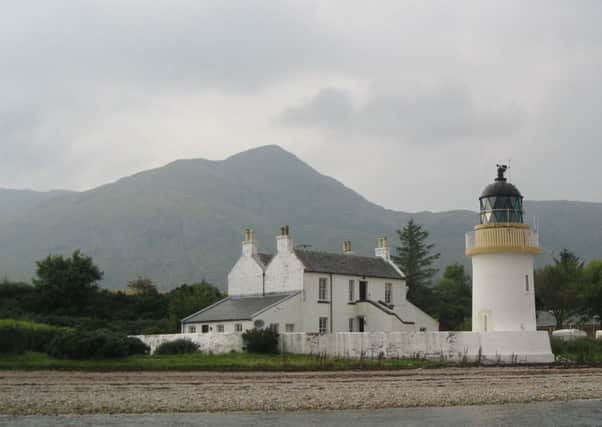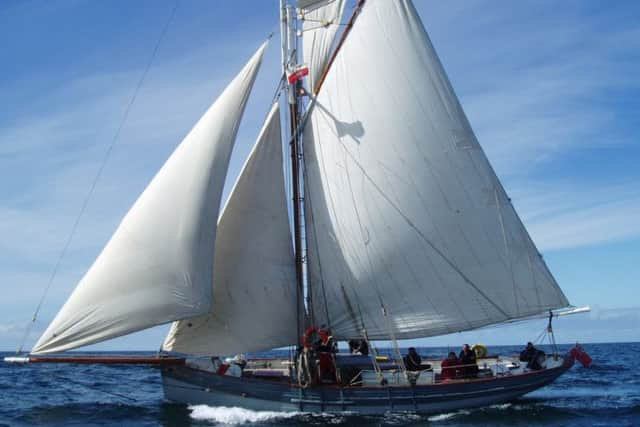Travel: Sailing through the Caledonian Canal


I realised it wasn’t quite a “cruise” when I was shown my berth. It required the agility of an Olympic gymnast to climb into and equal skill to avoid trampling my crewmate on the way out. After three nights I concluded that, if only I could remember where I was a few seconds before my head hit the timbers above it, life would be much improved.
After a night in Glasgow and an early train from Queen Street station, I joined the Lizzie May at her berth a few miles north of Oban. Owner and skipper Jerry Headley had been persuaded to include the Caledonian Canal cruise in her programme by a couple of tall ship veterans who wanted to add the trip to their log books.
Advertisement
Hide AdAdvertisement
Hide AdIf you’d like to experience life aboard an authentic wooden sailing ship but you’re not sure you’re quite ready for the open ocean, then a voyage on the Lizzie May, through the Great Glen, from Oban to Inverness, is an ideal way to test the waters.


The 42ft Lizzie May is a replica of a Scilly Isles pilot cutter, built in Cornwall in 1998 by celebrated boat builder Luke Powell and refurbished in 2001. Pilot cutters were used to carry pilots out to ships approaching the British Isles. They had to be fast – pilots were in competition with one another – and seaworthy, staying out when the weather would send other vessels scurrying for a safe harbour.
We wouldn’t need to worry too much about the weather on this trip though as we’d be on relatively sheltered lochs and the canal. We left Loch Creran on a beautiful September afternoon to enter Loch Linnhe, heading north-east and passing the picturesque Corran lighthouse. The aim was to get into the canal basin at Corpach, near Fort William, before nightfall. The trip would take about two and a half days with three nights aboard.
The 60-mile Caledonian Canal links four lochs including Lochy, Oich and Ness making a fascinating journey through the heart and history of the Highlands.
The canal was built in the early 19th century by Thomas Telford to provide a short cut between the North Sea and the Atlantic Ocean, avoiding the hazards of Cape Wrath and the Pentland Firth. The canal created a new route for commercial traffic but it also provided jobs in an area devastated by the Highland Clearances.
Designed for large cargo ships, the locks are on an epic scale. Between Corpach and Loch Ness there are 20, including a flight of eight at Banavie known as Neptune’s Staircase. These lift boats to over 100ft above sea level at the canal’s highest point. There are 29 locks in all but fortunately you don’t have to wind up all those gates by hand, the job’s done for you by the good folk of British Waterways. Once or twice we had to be careful that the water boiling up from the sluices didn’t push a deep-keeled boat like Lizzie May into the lock walls.
A major attraction of this trip is the contrast between the majestic scenery of the lochs and the peaceful, bucolic canal stretches.
As we headed out into Loch Ness on the second day I took the tiller for a spell, feeling the water pushing against the rudder, picking a point on the horizon and steering for it. Boats on the canal need to follow channels and spotting the red and green navigation marks, which appear to move in relation to each other and to the land, keeps you alert. It’s more of a cruise than a sail but, conditions permitting, there could be some sailing on the larger lochs – we managed to hoist the staysail on Loch Ness.
Advertisement
Hide AdAdvertisement
Hide AdAs we cruised up the loch, the ghostly shape of Urquhart Castle appeared from the mist and cloud swirling around the hills. The castle is steeped in blood – repeatedly attacked, seized and reclaimed. It figured prominently in the struggle for independence and came under the control of Robert the Bruce after he became King of Scots. In the 15th and 16th centuries, the castle and glen were frequently raided from the west by the ambitious MacDonald Lords of the Isles.
As for life on board, quarters are basic but comfortable. The Lizzie May can sleep seven, eight at a severe pinch but there were just six of us on this trip, including our skipper. She’s a beautiful boat, from the name carved into the stern to the intricate scroll work on the bow and many people along our route paused to take photographs of her. Below decks the cabin is a miracle of planning, with every inch of space used.
The polished timbers give a cosy feel and there’s even a tiny solid fuel heater with a surround of Delft tiles depicting sea monsters. It’s amazing what can be conjured up on the small gimbal mounted stove and we ate well.
My crewmates included a French language teacher, a retired telecoms engineer, a hairdresser and an industrial chemist. Most had done a fair bit of sailing but were not so familiar with taking a large boat through even larger locks.
This is not a trip to lie back with a drink in your hand – there’s plenty of work for everyone and you soon find a role you’re comfortable with. You need to be fairly robust however – if you don’t get the drill on the second time of asking you may receive very loud and public advice on your shortcomings!
It’s a bit like a game of cricket crossed with a motivation awayday – long periods of relative calm broken by sudden bursts of frenetic activity, when mooring or negotiating a lock.
There are not too many attractions at the overnight stops but the point of a trip like this is to live aboard and to get to know your crewmates. There’s certainly not much privacy below decks although showers are available ashore.
Fort Augustus does offer a chance to visit pubs and even do a little shopping. The splendid Bothy restaurant and bar is recommended and That Cute Little Highland Shop is good for arts, crafts and gifts.
Advertisement
Hide AdAdvertisement
Hide AdThere was plenty of wildlife too on this trip. We spotted porpoise on the way to Corpach and the trip list included eider ducks, gannets, guillemots, grey seals, goosanders, oystercatchers and a red kite.
At Inverness you can walk along the canal from Seaport marina to the final sea lock and imagine continuing the voyage out into Beauly Firth and the North Sea, perhaps heading for a Baltic port.
We settled for a few pints at the Clachnaharry Inn before returning to the Lizzie May. If I woke with a sore head the next morning it wouldn’t be the boat’s timbers that did the damage this time.
• Lizzie May’s season starts in April. As well as the Caledonian Cruise the programme includes trips to the Inner Hebrides, sealoch exploration and taster weekends.
The Caledonia Cruise is available 26-29 June and 3-5 July, two day, £280 (per person), three day, £420pp; www.sail-lizziemay.com